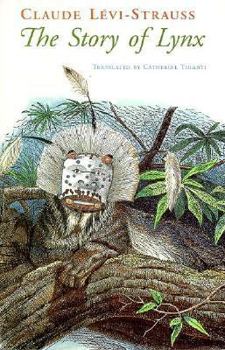The Story of Lynx
Select Format
Select Condition 
Book Overview
"In olden days, in a village peopled by animal creatures, lived Wild Cat (another name for Lynx). He was old and mangy, and he was constantly scratching himself with his cane. From time to time, a young girl who lived in the same cabin would grab the cane, also to scratch herself. In vain Wild Cat kept trying to talk her out of it. One day the young lady found herself pregnant; she gave birth to a boy. Coyote, another inhabitant of the village, became indignant. He talked all of the population into going to live elsewhere and abandoning the old Wild Cat, his wife, and their child to their fate . . . " So begins the Nez Perc myth that lies at the heart of The Story of Lynx, Claude L vi-Strauss's most accessible examination of the rich mythology of American Indians. In this wide-ranging work, the master of structural anthropology considers the many variations in a story that occurs in both North and South America, but especially among the Salish-speaking peoples of the Northwest Coast. He also shows how centuries of contact with Europeans have altered the tales. L vi-Strauss focuses on the opposition between Wild Cat and Coyote to explore the meaning and uses of gemellarity, or twinness, in Native American culture. The concept of dual organization that these tales exemplify is one of non-equivalence: everything has an opposite or other, with which it coexists in unstable tension. In contrast, L vi-Strauss argues, European notions of twinness--as in the myth of Castor and Pollux--stress the essential sameness of the twins. This fundamental cultural difference lay behind the fatal clash of European and Native American peoples. The Story of Lynx addresses and clarifies all the major issues that have occupied L vi-Strauss for decades, and is the only one of his books in which he explicitly connects history and structuralism. The result is a work that will appeal to those interested in American Indian mythology.
Format:Hardcover
Language:English
ISBN:0226474712
ISBN13:9780226474717
Release Date:June 1995
Publisher:University of Chicago Press
Length:294 Pages
Weight:1.05 lbs.
Dimensions:0.9" x 5.9" x 8.8"
Customer Reviews
1 rating
Twins in American Indian Mythology and Social Life
Published by Thriftbooks.com User , 19 years ago
In this comparatively accessible later work, anthropologist Claude Levi-Strauss illustrates his trademark methods of comparative and contextual analysis, his deep respect for American Indian cultures and systems of thought, and his unique gifts as a creative interpreter of the social world. _The Story of Lynx_ takes up new work but also offers new readers a glipse of the larger set of projects Levi-Strauss pursued over the course of much of the 20th century. Readers in particularly will get a taste of the mythological analysis at the center of his great four volume work known collectively as _Mythologiques_. At the center of _The Story of Lynx_ is a quest to understand ideologies of twinship and the broader set of principles that have come to be known among anthropologists as dual organization and as "dualism" as a wider social ideology. Here Levi-Strauss focuses on an interconnected series of myths from the Northwest of North America. The stories, rich in themselves, center on the adventures of Lynx and Coyote and explore such themes as the origin of fog, the nature of (in)appropriate marriage, the cosmology of Sun and Moon, and the significance of bodily ornament. The stories, explored comparatively and in the contexts of the societies in which they are told, reveal complex patterns both in historical relationships between groups and in the social philosophies and ideologies out of which they emerge. Levi-Strauss' project is advanced here in two particular domains--an exploration of the ways European tales were incorporated into native mythologies and in trying together his findings about dualism in the mythological and sociological domains. He also offers a defense of his work against what he holds were misreadings by other scholars. For students and other interested readers seeking an entry point and introduction to Levi-Strauss' larger body of work on Native American mythology, _the History of Lynx_ is a logical and rewarding beginning. Students more interested in the link between myth and visual art, would be similarly rewarded by his _Way of the Masks_. His collections of essays and his masterworks _Triste Tropiques_, _The Savage Mind_ and _The Elementary Structures of Kinship_ remain landmark works in anthropology, depite now well-established moves by many contemporary scholars away from structuralist theories toward so-called post-structural and post-colonial ones.





